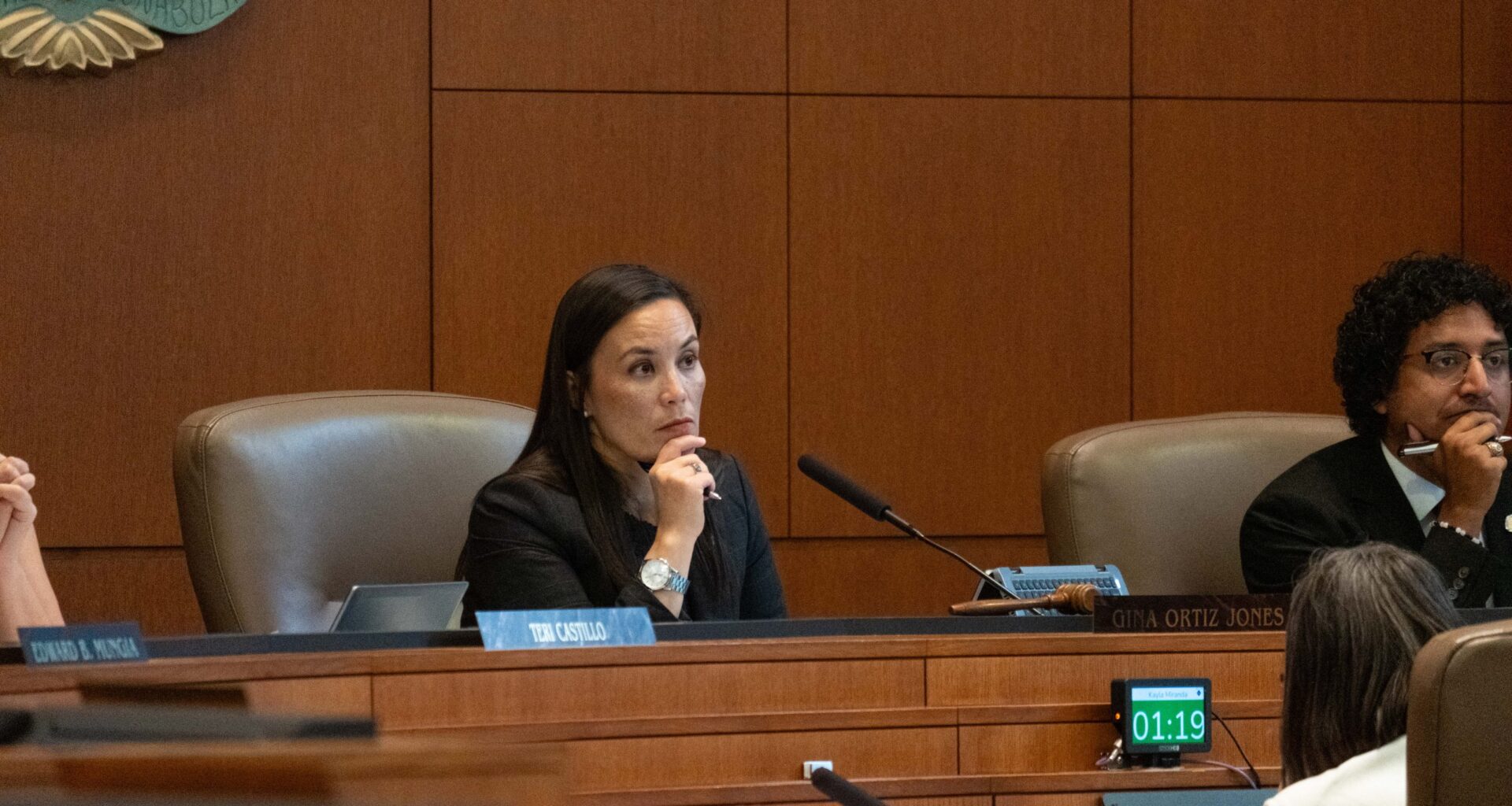The San Antonio City Council voted down Mayor Gina Ortiz Jones’s plan to “pause” negotiations on Project Marvel Thursday — instead forging ahead with a broad agreement to spend roughly a half-billion dollars on a new downtown Spurs basketball arena.
The council voted 7-4 on Thursday to authorize City Manager Erik Walsh to execute a “nonbinding term sheet” indicating that the city would commit to providing $489 million for an arena that’s expected to cost roughly $1.3 billion.
Jones, along with progressive council members Teri Castillo (D5), Ric Galvan (D6) and Leo Castillo-Anguiano (D2) voted against the term sheet.
Councilman Edward Mungia (D4) sided with the more business-friendly members on their dais, Sukh Kaur (D1), Marc Whyte (D10), Marina Aldrete Gavito (D7), Misty Spears (D9), Ivalis Meza Gonzalez (D8) and Phyllis Viagran (D3). Castillo-Anguiano is temporarily representing District 2 while Councilman Jalen McKee-Rodriguez is on paternity leave.
Approval from San Antonio voters isn’t needed for the city to spend that money. But voters will get to approve or reject the last piece of the puzzle, $311 million in venue tax funding from Bexar County, on the Nov. 4 ballot.
Jones refused to go quietly and told council members she wanted to put the city’s contribution on the ballot with a May infrastructure bond, that way the public would have a chance to weigh in.
“I do want to manage the expectations of my colleagues that I will be seeking their support for such an ordinance [that would give] the public an opportunity not only to vote on the county’s contribution … but on the city’s contribution as well,” Jones said after the term sheet was approved.
The mayor had been calling for the City Council to hold off on approving the term sheet until it could procure an “independent” economic analysis and do proper “due diligence” on such a sizable investment.
Currently the only analysis that exists was produced with data provided by the Spurs, by a company with business ties to the team.
“Due diligence is not anti-progress, it is anti-poverty,” said Jones, who during her mayoral campaign repeatedly pointed to the Alamodome as a failure of past leaders who made decisions based on “hope” and failed to deliver the city an NFL team.
“We have seen in our community the times where we have not necessarily done our due diligence, and we can see the impacts of those each day,” said Jones, who put a resolution on Thursday’s agenda calling for the independent analysis and two public input meetings in each council district to be completed before voting on the term sheet.
Despite Jones’ public pressure on fellow council members, they voted 7-4 against her resolution. Castillo, Galvan and Castillo-Anguiano were the only members to support it.
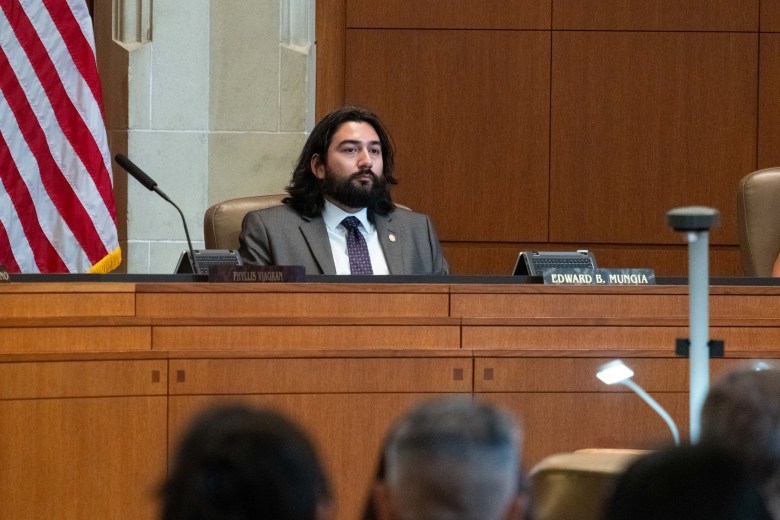 District 4 Councilmember Edward Mungia listens to comments from the public about Project Marvel on Thursday. Credit: Amber Esparza / San Antonio Report
District 4 Councilmember Edward Mungia listens to comments from the public about Project Marvel on Thursday. Credit: Amber Esparza / San Antonio Report
The vote followed two weeks of repeated disagreements between council members and the mayor on policy-making procedures, committee assignments and decorum in public meetings.
Whyte — who had some of the most heated exchanges with the mayor over the arena deal — said he hoped both the council and the community could move past their disagreements on what proved to be a divisive, emotional vote.
“The points that the mayor has raised, I’m appreciative of those. They are well-taken, and everybody deserves to have a voice,” he said. “[But] we’ve got to come together after this. We are better when we work together.”
Several council members said the city could move forward with some of the mayor’s demands for more community engagement and number-crunching even though they accepted the term sheet Thursday.
“We can still continue to collect information and get economic analysis, even after we proceed with the term sheet,” said Spears, one of the few conservatives on the dais, who acknowledged the pushback she’s received from constituents in her Northside district.
She and Mungia and Galvan, more progressive council members, suggested hosting more town halls to get voter feedback on the community benefits and to explain funding mechanisms.
“Technically there is the flexibility to change the parameters if the other party agrees,” Mungia said. “We still have the ability to get out of this deal at any point before other project deals are signed.”
An emotional vote
At Thursday’s meeting, 109 people signed up to speak on the issue — and many more lined up down the block to pack the council chambers during a contentious vote.
Their perspectives ranged from impassioned pleas to keep the Spurs from decamping for another city to disgust at city leaders they say negotiated behind closed doors for far too long before bringing the public in on their plans.
Castillo-Anguiano, one of the most outspoken opponents of approving the term sheet, blamed a “fumbled” public engagement effort from the city for the outpouring of frustration from residents. Residents of his Eastside district, where the Spurs currently play their games at the Frost Bank Center, had called his office with concerns about the new arena.
“The folks who are asking us to vote ‘yes’ on this term sheet, the majority were all wearing fancy business suits,” Castillo-Anguiano said. “ … On the other hand, the folks who are asking us to vote ‘no’ on this term sheet are majority working-class folks who are probably missing work just to be here. I think that speaks volumes.”
Viagran, meanwhile, suggested those who opposed the deal weren’t adequately concerned about keeping the team in San Antonio.
“You either trust this team … or you don’t,” Viagran said. “I’ve heard so many people say, ‘We all love the Spurs.’ … But do you really?”
Supporters and opponents alike grew heated as Jones called on Spurs chairman Peter J. Holt, asking three times whether the team would be OK with the city taking time to conduct its own economic analysis to check the work.
Holt didn’t say yes — and he didn’t budge. The Spurs were confident in the data they had produced, he said, and wanted to move forward with their investment in the arena and in the surrounding downtown area.
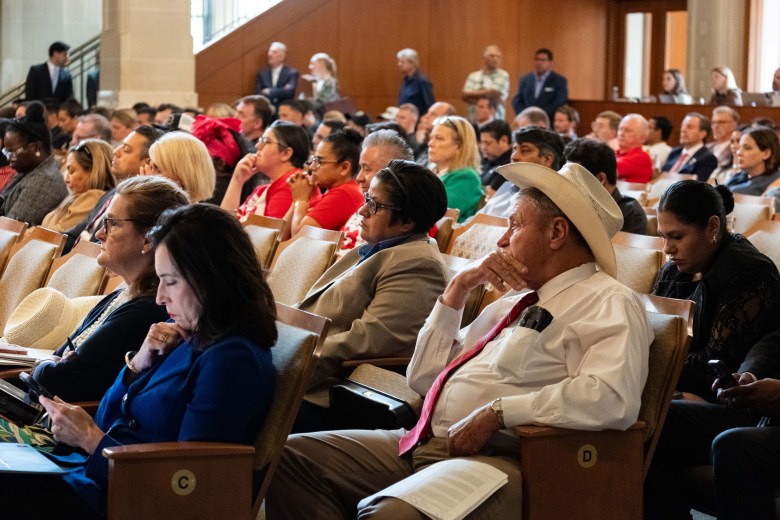 Attendees listen during the Thursday council meeting. Credit: Amber Esparza / San Antonio Report
Attendees listen during the Thursday council meeting. Credit: Amber Esparza / San Antonio Report
“We feel like there’s tremendous positive data that shows this project, this arena, is going to be great for San Antonio, and that’s why we’re willing to make an historic investment in our community,” Holt said, to cheers from the audience.
At the same time Jones was calling for a pause, council members who support the proposed downtown entertainment district were pushing hard to move forward with a deal.
Many of them had served on the council or worked at the city throughout the past two years of negotiations, and believed it was past time for the city to formalize its commitment to the Spurs.
The team’s owners have committed at least $500 million for arena construction, and to bring in development around the arena with $1.4 billion in taxable value.
That would help the city maximize the Project Finance Zone surrounding the arena, which allows it to collect the growth in state taxes from hotels and businesses within a three-mile radius.
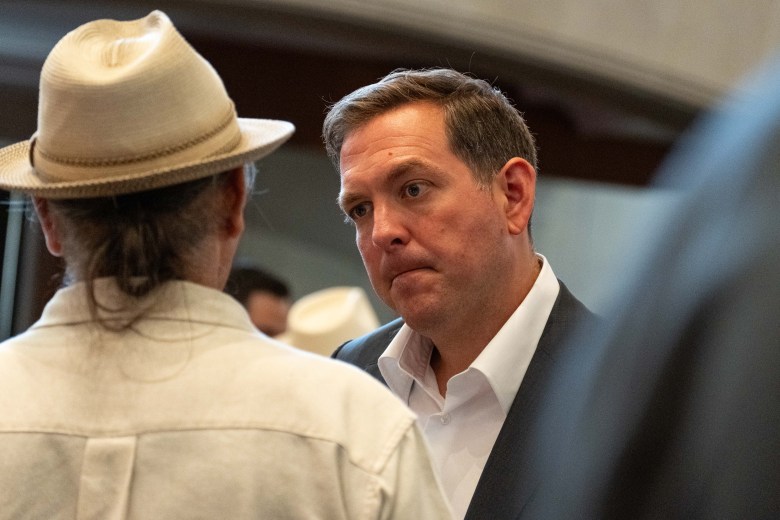 San Antonio Spurs Managing Partner Peter J. Holt talks to community members during a recess before the council’s first vote Thursday. Credit: Amber Esparza / San Antonio Report
San Antonio Spurs Managing Partner Peter J. Holt talks to community members during a recess before the council’s first vote Thursday. Credit: Amber Esparza / San Antonio Report
San Antonio plans to use that money to double the size of the Henry B. Gonzalez Convention Center and pay for improvements to Alamodome, which city leaders say they couldn’t afford otherwise.
So compelling were the Spurs’ offers, the council members said, that five of them called Walsh hours after city staff completed negotiations with Spurs ownership over the weekend, asking him to buck the mayor’s wishes and put the term sheet on Thursday’s council agenda.
A done deal?
Broadly speaking, the term sheet says that the city will contribute $489 million to the arena, Bexar County will contribute $311 million, and Spurs will pay for the rest of the arena costs, including any expenses beyond the initial $1.3 billion estimate.
The city will own the arena and the Spurs will have the exclusive naming and advertising rights. The agreement also includes a nonrelocation agreement, meaning the Spurs can’t move to another city until 2062.
Though the term sheet is nonbinding, Thursday’s meeting could be among the last major public votes on the city’s commitment to the Spurs arena.
The city’s contribution to the arena doesn’t require a public vote because it comes from a mixture of state and local tax reinvestments and revenues from leasing the arena and the land around it. City officials said they are borrowing against that mixture of funding sources, which are already voter-approved.
Voters will be asked to approve Bexar County’s $311 million contribution in November — as well money for improvements to other county-owned buildings like the Spurs’ current home on the East Side, the Frost Bank Center.
Walsh told reporters that if the county votes fail, the Spurs will have to decide whether there’s still a path to relocating from their existing home at the East Side’s Frost Bank Center. The team’s lease there runs through 2032.
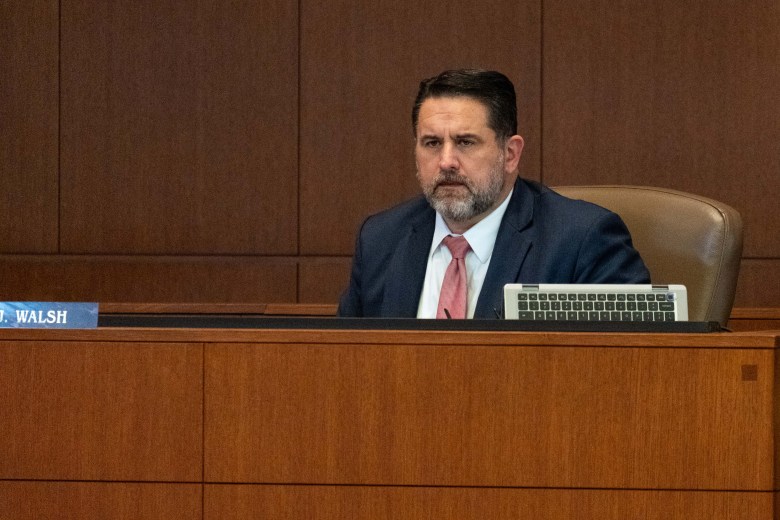 City Manager Erik Walsh listens to comments from the public during Thursday’s City Council meeting at San Antonio City Hall. Credit: Amber Esparza / San Antonio Report
City Manager Erik Walsh listens to comments from the public during Thursday’s City Council meeting at San Antonio City Hall. Credit: Amber Esparza / San Antonio Report
After both votes, Holt said the deal had “maximum mutual benefit” and he expressed confidence that the county portion of the funding would pass in November.
“The information that we’ve collected so far has been tremendously positive for support of the Spurs, support of a Spurs Arena in our urban core that’s accessible and unifying and exciting and fun for our community,” he said.
If the county’s ballot items are successful, San Antonio plans to ask voters for a bond election as early as May of 2026 to fund some streets and infrastructure surrounding the sports and entertainment district — as well as other bond projects across the city.
“If the council was to call for a bond program in May, they’d have to call it by the second week in February, which is really not that far away,” Walsh told reporters
Details revealed
The term sheet presented Thursday laid out many previously unreported details about the new Spurs arena — many of which would still require approval by the NBA.
The terms sheet discusses a 17,000- to 18,500-seat arena that would be constructed in just under five years and open in 2032 for the NBA season. The city and the Spurs would later negotiate any needed renovations between 2045 and 2048.
The city would own the arena, but the Spurs would be responsible for maintenance at a cost of around $25 million a year, team representatives said at an Aug. 6 council meeting.
The Spurs would pay the city $4 million every year to lease the arena and would retain naming and advertising rights. The Spurs would also pay arena employees $18/hour, at a minimum.
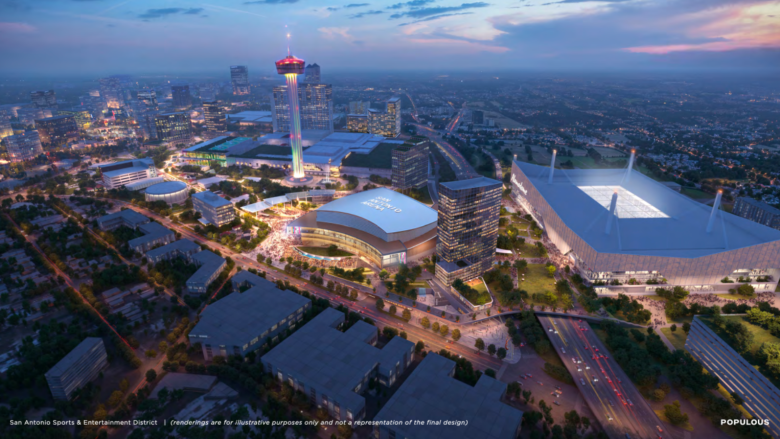 A rendering of the San Antonio Sports and Entertainment District. Credit: Courtesy / Populous
A rendering of the San Antonio Sports and Entertainment District. Credit: Courtesy / Populous
The term sheet would also tie the Spurs to San Antonio for 30 years with a nonrelocation agreement. The team would be allowed to play four home games outside the arena, as well as neutral or international site games as required by the NBA.
The Spurs would make further financial commitments to the city, including $75 million in community benefits paid over 30 years and gifting the city a $30 million parcel of land near the new arena site.
The NBA would also review the nonbinding term sheet before it can be set in stone.
“The NBA will need to approve the design of the arena and the Spurs obligations under the project agreements, including debt to be incurred by the Spurs,” according to the term sheet. “The project agreements will include provisions to mitigate negative impacts, if any, of NBA rule changes on the parties’ interests in the arena or other matters that are the subject of this term sheet.”
